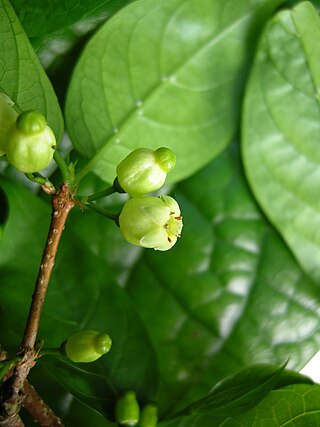
Canthium is a genus of flowering plants in the family Rubiaceae. They are shrubs and small trees. The leaves are deciduous and the stems are usually thorny.

Gaertnera is a genus of flowering plants in the family Rubiaceae. There are at least 85 species distributed across the Old World tropics from Africa to Asia.
Ixora foliosa is a species of flowering plant in the family Rubiaceae. It is found in western Cameroon and eastern Nigeria. Its natural habitats are subtropical or tropical moist lowland forests and subtropical or tropical moist montane forests. It is threatened by habitat loss.
Mitriostigma barteri is a species of plant in the family Rubiaceae. It is found in Cameroon and Equatorial Guinea. Its natural habitat is subtropical or tropical moist lowland forests. It is threatened by habitat loss.
Pavetta monticola is a species of plant in the family Rubiaceae. It is found in Equatorial Guinea and São Tomé and Príncipe.
Robynsia is a monotypic genus of flowering plants in the family Rubiaceae. It was described by John Hutchinson and was named after his friend and colleague Walter Robyns. The genus contains only one species, Robynsia glabrata, which is found in Ghana, Ivory Coast and Nigeria. The species is morphologically similar to the genus Cuviera but differs by having long, slender corolla tubes.

Rothmannia is a genus of flowering plants in the family Rubiaceae. It was described in 1776 and is named for Göran Rothman (1739–1778) by Thunberg – both were pupils of Linnaeus.

Rytigynia is a genus of flowering plants in the family Rubiaceae. It is found in tropical and southern Africa. The genera Rytigynia and Fadogia form a strongly supported clade but neither of these genera is monophyletic.
Vangueria schliebenii is a species of flowering plant in the family Rubiaceae. It is endemic to Tanzania.
Tapiphyllum was a genus of flowering plants in the family Rubiaceae but is no longer recognized. In 2005, a molecular phylogenetic study showed that the type species, Tapiphyllum cinerascens, is more closely related to Vangueria than to Tapiphyllum obtusifolium and Tapiphyllum velutinum. It is not clear whether the latter two species are really separate from Vangueria. All the species of Tapiphyllum have been sunk into synonymy with Vangueria.

Vangueria is a genus of flowering plants in the family Rubiaceae. The genus is named for Voa vanguer, as V. madagascariensis is known in Malagasy.

Vanguerieae is a tribe of flowering plants in the family Rubiaceae and contains 671 species in 29 genera. It is one of the most species-rich groups within the family and it is distributed across the Paleotropics.

Fadogia is a genus of flowering plants in the family Rubiaceae. The genera Rytigynia and Fadogia form a strongly supported clade but neither of these genera is monophyletic.
Vangueriopsis lanciflora is a species of flowering plants in the family Rubiaceae. The species has the largest distribution area of the genus and occurs in Central and South Tropical Africa.

Canthium armatum is a species of flowering plants in the family Rubiaceae. It is a shrub or tree native to southern Mozambique, Eswatini, and KwaZulu-Natal and the Northern Provinces of northeastern South Africa. The species is characterized by the presence of large spines.

Meyna is a genus of flowering plants in the family Rubiaceae.
Ancylanthos was a genus of flowering plants in the family Rubiaceae but is no longer recognized. It was originally described by René Louiche Desfontaines in 1818. In 2005, it was sunk into synonymy with Vangueria, based on a phylogenetic study of DNA sequences.
Vangueria cinerascens is a species of flowering plant in the family Rubiaceae. It is found from Tanzania to South Tropical Africa. The epithet is a Latin adjective meaning ash-coloured, referring to the indumentum on the leaves.
Vangueria cistifolia is a species of flowering plant in the family Rubiaceae. It is found in Angola and Zambia.








